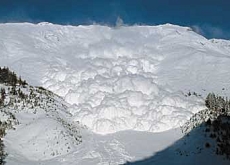
scientists go with the hazard flow

A two-dimensional computer model developed in Switzerland is expected to make natural mountain hazards more predictable.
The Rapid Mass Movements or Ramms project at the Federal Institute for Snow and Avalanche Research in Davos integrates avalanches, debris flows and rock falls into one simulation tool.
The institute has been conducting research for 70 years now but still cannot predict the precise time, place or scale of an avalanche.
Field and laboratory experiments are continuing to be conducted, however, and when complete, the Ramms model will make forecasting more accurate.
“We can simulate more complicated problems,” scientist Marc Christen tells swissinfo about the two-dimensional aspect of the model.
He says that one of the main advantages it has over the one-dimensional tools currently used is the removal of much of the guesswork. “If you have an avalanche release zone, you get a
better impression of where the snow will descend, for example, how much will go down on the left or right side,” he explains.
Research and forecasting
The institute’s Birgit Ottmer says it is the only facility in the world that combines research and avalanche forecasting under one roof.
“The forecasters receive the latest information from the researchers and the researchers in turn are asked questions by the forecasters, which have important practical and not just theoretical implications,” she says.
Issuing avalanche warning bulletins and providing other data to the regional authorities in Switzerland
so they can produce hazard maps – essential for land-use planning – are key services of the institute.
The Ramms project will make the planning easier. “Practitioners and civil engineers want to know about velocities, pressure forces, snow and mud heights, and this will give it to them,” Christen adds.
He says avalanche modelling is already quite advanced, with much work still needing to be done on landslides, or what are termed “debris flows”.
These occur frequently in late spring and summer, triggered by rapid snow melt and intense thunderstorms.
Landslides and flooding caused by
torrential rains last August killed six people in Switzerland.
The institute estimates that there have been 500 such debris flows in the country over the past 30 years, resulting in 20 fatalities and approximately SFr360 million ($285 million) worth of damage to infrastructure.
Modelling
An exciting aspect of the Ramms model is the capability to figure in snow cover and terrain, and so-called mitigating features, such as forests or man-made barriers that can prevent or slow hazardous flows.
“The goal is then to calculate all the different modules for an area to
produce a comprehensive natural hazard map, not just for avalanches,” Christen says.
The snow pack module can, for instance, calculate interactions between snow accumulation and the formation of an avalanche.
When it comes to rock falls, Ramms provides insight into trajectory of boulders, their speed and bouncing height. The debris flow module allows solids (boulders) and liquids (water) to interact.
While the dangers of the mountains are not to be underestimated, the Swiss have already come along way as far as risk management is concerned. Ottmer believes the institute has played an important role in saving lives.
“The winter of 1999 was a so-called avalanche winter with huge amounts of snowfall,” she says.
“It was comparable to 1951 when almost 100 people died in avalanches. Less than 20 were killed in 1999, despite the fact that there were more people living, working or on holiday in the Alps that year.”
swissinfo, Dale Bechtel in Davos
The Swiss Federal Institute for Snow and Avalanche Research was founded in 1931 in Bern.
The first “snow laboratory” was built at 2,662m on the Weissfluhjoch above Davos five years later.
The institute does research and publishes daily avalanche warning bulletins for Switzerland.
It was integrated into the Swiss Federal Institute for Forest, Snow and Landscape Research in 1989.

In compliance with the JTI standards
More: SWI swissinfo.ch certified by the Journalism Trust Initiative





























You can find an overview of ongoing debates with our journalists here . Please join us!
If you want to start a conversation about a topic raised in this article or want to report factual errors, email us at english@swissinfo.ch.